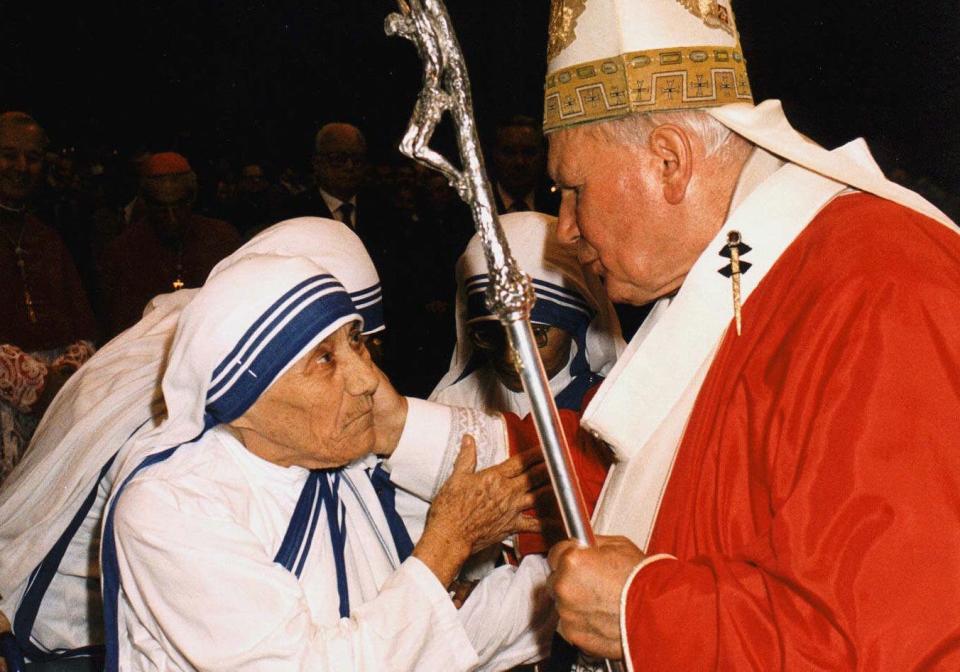LOOKING BACK AT OUR HISTORY: Mother Teresa, the Saint of Calcutta
- Oops!Something went wrong.Please try again later.
- Oops!Something went wrong.Please try again later.
(Note: This is the eighth essay in a series on “Notable Women.”)
In an American culture increasingly driven by “The Self,” Mother Teresa’s unrelenting selflessness offers us an alternative model for living our lives.
Mother Teresa was born Anjezë Gonxhe Bojaxhiu in 1910 in the city of Skopje, then a part of the Ottoman Empire and now the capital of North Macedonia.
As a young girl, she was fascinated by stories of Christian missionaries and by 12 felt a strong calling to the religious life. “It was then that I first knew I had ad vocation to the poor … in 1922. I wanted to be a missionary, I wanted to go out and give the life of Christ to the people in the missionary countries …. “…it was the will of God. It was His choice.”

At 18, she left home to join the Sisters of Loreto at Loreto Abbey in Ireland, an order of nuns which had education as its primary focus. There she learned English, the language the Loreto Sisters used in India.
She took her first vows as a nun in 1931, when she began her service in Bengal, India, and her solemn, final vows in 1937.
On Sept. 10, 1946, while riding a train, she stated that she had a mystical encounter with Christ, described in “Mother Teresa, Come Be My Light: The Private Writings of the ‘Saint of Calcutta,’” edited by Brian Kolodiejchuk.
“[It] was a call within my vocation. It was a second calling. It was a vocation to give up even Loreto where I was happy and to go out in the streets to serve the poorest of the poor.” “I knew it was His will and that I had to follow Him.”
She always held this day to be the real beginning of the Missionaries of Charity. To the end of her life she maintained that the first purpose of the congregation she founded was “to satiate the thirst of Jesus Christ on the Cross for Love and Souls.”
It took four years of prayer, hard work, entreaty, and delay; however, the Catholic Church finally in 1950 agreed to the official formation of the congregation. On October 7, 1950, the Society of the Missionaries of Charity in the archdiocese of Calcutta was established.
The sisters who chose to join were required to take four Vows: Poverty, Chastity, Obedience, and devotion to the poor, to include the abandoned, the sick, the infirm, and the dying.

Two years later she opened her first hospice, eventually naming it Kalighat, the Home of the Pure Heart. The services offered were free to the poor, including medical care and the opportunity to die with dignity in accord with their respective faiths. Muslims were read the Quran, Hindus received water from the Ganges, and Catholics received the final sacrament, the Anointing of the Sick.
In 1958, she opened a hospice for lepers, calling it Shanti Nagar (City of Peace) and also clinics for them throughout Calcutta. She also established homes for orphans and homeless children.
By the 1960s, she was able to open hospices, orphanages, and leper houses throughout India.
In 1965, the congregation opened its first house abroad in Venezuela. More houses followed in 1968 in Italy, Tanzania, and Austria.
In the 1970s, the congregation expanded operations to the United States and dozens of other countries in Asia, Africa, and Europe.
Ironically, while heading such a far flung, spiritual congregation, she was burdened with an interior, spiritual darkness, revealed only to a handful of her spiritual advisors. She spoke to this darkness and emptiness in her letters, beginning in 1953.
“Please pray specially for me … for there is such terrible darkness within me, as if everything was dead. It has been like this more or less from the time I started ‘the work’”.
In 1964, she wrote: “In my soul, I can’t tell you how dark it is, how painful, how terrible. My feelings are so treacherous.”
In 1977, she wrote: “As for me, the silence and the emptiness is so great that I look and do not see, listen and do not hear. The tongue moves but does not speak.”
Brian Kolodiejchuk describes her spiritual journey in accepting the pain and darkness, even coming “to love it.” “Mother Teresa had reached a point in her life when she no longer ventured to penetrate or question the mystery of her unremitting darkness. She accepted it, as she did everything else that God willed or at least permitted, ‘with a big smile.’”
She received numerous awards and honors during her lifetime, including the Nobel Peace Prize in 1979. In 1999, she headed Gallup’s List of Most Widely Admired People of the 20th century. In 2016, the Catholic Church canonized her, making her a saint.
Her health declining in the 1980s, she still maintained a rigorous pace until her death on Sept. 5, 1997.
By 2007, the Missionaries of Charity numbered some 5,000 sisters and 450 brothers, operating 600 missions, schools and shelters in 120 countries. In 2020, it consisted of 5,167 religious sisters.
Fred Zilian (zilianblog.com; Twitter: @FredZilian) is a retired educator and a regular columnist.
This article originally appeared on Newport Daily News: LOOKING BACK AT OUR HISTORY: Mother Teresa, the Saint of Calcutta

